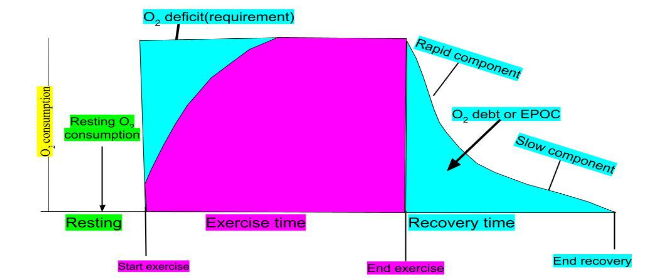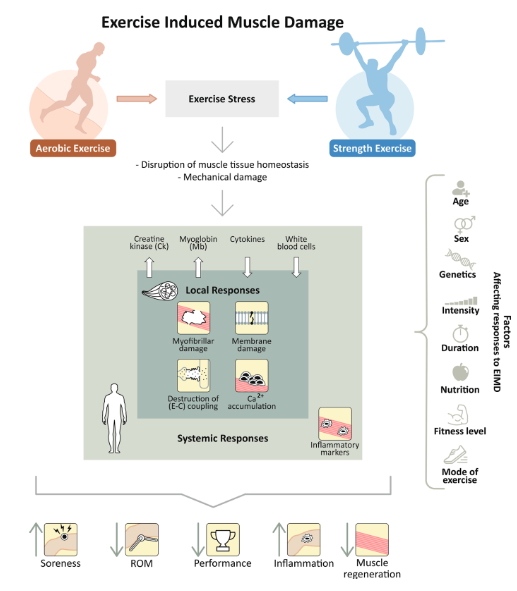Whenever we run, jump, intercept and do a long-distance event we use our muscle stores of creatinine, glycogen, and fat stores to replenish us with energy. Along with this comes the microdamage in the muscles and the change in the structural integrity of the connective tissues surrounding it.
So to perform again the next day, to the best of our abilities and strength we need to refuel all the emptied energy stores and repair the muscle damage. This is what sets the process of “recovery”.
WHAT IS RECOVERY?
Recovery after any strenuous exercise, physical activity, or a sport session is the time and process required to get the physiological, structural, and psychological parameters back to the baseline levels, for an individual athlete to perform at her best in successive sessions.

WHAT CAUSES THE NEED TO RECOVER?
- Decrease in the energy fuel: Exercise uses the fuel of carbohydrates, fats, and proteins to sustain activity. For short events lasting less than eight seconds, the primary source of energy is the phosphocreatine system while for the increasing intensities and duration of exercise, progressively carbohydrates and fats are utilized. If one continues to run or play with emptied fuel stores the next day, he or she might suffer from an injury or exhaustion.
- Exercise-Induced Muscle Damage(EIMD): the muscle fibres suffer microdamage i.e. micro tears when they contract in the lengthened position. There is an apparent change in the length of the muscle fibres due to the building up of excess chemicals and edema, causing the muscle to be in a shortened state.
3. The Oxygen Debt – Have you observed that your heart rate and breathing rate speed up at the end of a heavy workout session? This is due to a deficit created in the oxygen supply and need. The contracting muscles need oxygen more during the exercise period, which is comparatively less than the demand. Hence, when the exercise is stopped, the body tries to replenish extra oxygen which it needs to wash out the waste metabolites in the muscles, also called excess post-exercise oxygen consumption(EPOC). The oxygen consumption is pressurised further if

working at high altitudes, with heat stress, and polluted air having other impurities.

After understanding what causes the need to recover, one might ask if recovery duration and processes need to be the same for everyone.
The answer would be no. Every person is different and also the training session is.
The multidimensional nature of the recovery
Recovery is not only physical, it is physiological which incorporates the use of different body systems to supply energy for the activity, and also psychological where your mind is afresh without any stressors from the previous activity. Hence we can remember the 3 Ps –
Physical, Physiological, and Psychological.
Thus factors contributing to all 3 Ps affect the rate of recovery and most of the interventions targeted to enhance the recovery like sleep, nutrition, and cryotherapy in a way try to influence at least one of the 3 Ps.
TRAINING FACTORS THAT MIGHT AFFECT THE RECOVERY :
- The mode of exercise – strength/power/speed session
- The length of the training session
- The difficulty level of tactical training
- The Heat Stress: Female sex is considered one of the risk factors for heat-related illnesses ranging from cramps to the near-fatal heat stroke
INDIVIDUAL FACTORS THAT MIGHT AFFECT RECOVERY
- Age – The older one is, the longer it takes to recover
- Sex – the female sex hormones affect the production of inflammatory blood markers periodically through different phases of the cycle
- Training with an injury
- Training with any vitamin, or mineral deficiency. Eg. Vitamin D, Magnesium deficiency are a few examples of minerals responsible for enhancing recovery
- Training after a long break
- Training age, status, and fitness levels: Training age is the years since one is following a good training program. Training for a long time adapts the body to handle higher workloads efficiently
- Nutrition and Sleep: These are the most important factors that aid in growth, repair, and replenishment. Sleep is the time when most of the repair work of the mind and body is done. Eating the right food with a good amount of proteins, carbohydrates and fats help in building the muscles which were used during the training.
What are the markers of recovery?
To know whether the recovery is happening or not we need to have measures to guide us if we are falling short of interventions to recover. These measures are –
- Biochemical measures: Creatinine Kinase(CK), Insulin-like growth factor 1, Cytokines like Interleukin 6, Urea, Glutamine, lactate, and so on.All of the above chemicals are produced with increased stress on the body and are cleared during the resting state. A continued increase in these markers can suggest delayed recovery from the training load.
- Endocrine measures: Thyroid Cortisol and Catecholamines(adrenaline, dopamine) give a picture of the total body response to stress and adaptation. Their change in levels in the body is an indication of a prolonged stress response
- The autonomic tone suggests readiness: Our heart receives nerve supply which speeds up and lowers our heart rate. The system which governs the heart rate rising and slowing, during and after the exercise respectively is the Autonomic nervous system.

The autonomic nervous system further has two subdivisions, sympathetic and parasympathetic systems. The sympathetic system is responsible for flight and responses, increasing the heart rate during exercise. While the parasympathetic system is responsible for the rest and digestion functions, decreasing the heart rate after exercise. The ability to calm down the heart rate after the exercise is governed by parasympathetic nervous system activation. When both these systems are balanced, the athlete shows a lowered Resting Heart Rate (RHR), a higher Heart Rate Variability(HRV), and a faster Heart Rate Recovery(HRR) after the training session. Heart rate being the most accurate and easy-to-monitor parameter gives one of the best predictions of autonomic system function, helping us to understand the recovery of the physiological and psychological state of the athlete.
- Physical measures: Muscles undergoing micro damage produce inflammatory substances called cytokines, along with other chemicals that give rise to reversible tightness seen as a reduction in range of motion and soreness. These factors can be measured and intervened with massage, mobility, and physiotherapeutic sessions restoring the muscle to its original length and preventing injuries.
5. Neuromuscular measures: The ability to produce force by the muscles is decreased at the end of a match or a training session. This reduction can be measured by performance-based tests like Countermovement Jump(CMJ), Peak Power Output(PPO), or through individual muscle contraction measures like Maximum Voluntary Contraction(MVC) which is the ability to contract a muscle to its maximum force. As the fatigue sets in, the ability of the body to produce force and
control the movement decreases, which requires a period of recovery where the neuromuscular fatigue is reversed.
- Psychological/Self-reported scales: These measures help in understanding the psychological load and mood states. Their ease of use and application in team sports settings have made them a staple in performance monitoring of psychological recovery.Profile of Mood States (POMS), Total Quality Recovery (TQR), Daily Analysis of life Demands of Athletes(DALDA), and Rate of Perceived Exertion(RPE) are a few examples.
How does sex affect recovery?
Sex affects recovery due to varied anatomical and physiological differences. This recovery can be assessed immediately after the exercise which is called short-term recovery. When recovery is assessed after a prolonged time such as 24 hours or more after a bout of exercise it is called long-term recovery. Women have lower muscle mass compared to men hence exercise-induced muscle damage is lesser in females compared to men. Along with that, the muscle fiber diameter is smaller in females, and also the fuel utilized to supply energy for the exercise like proteins, carbs, and fats differ in females due to the effect of the changing hormones during the menstrual cycle.
SHORT TERM RECOVERY
Any activity lasting for less than half an hour can be classified as a short-duration activity. This also has implications for substrate utilization to supply energy which is majorly from phosphate creatinine and anaerobic power systems. Hence the biomarkers used are by testing blood lactate and adenosine levels to estimate short-term recovery. Also, recovery just after an exercise can be measured best with heart rate recovery (HRR), which is the time taken for the heart rate to return to the baseline levels.
Few studies have shown that females can maintain better power outputs than men during intermittent sprint training but this data hasn’t been replicated, and few other studies have shown almost the same results as men when the power output was compared with the amount of muscle mass they were having. HRR is generally determined by the state of the parasympathetic system and the trained status of an athlete. The HRR was faster in males compared to females for anaerobic exercise. Also, it was found that females had higher chances of not adapting well to orthostatic stress. Orthostatic Hypotension is low blood pressure caused due to sudden changes in activity. This generally happens due to the pooling of blood in lower limbs after a sudden stop in continuous exercise. The person suffering from hypotension feels dizzy as there is a relatively low blood supply to the brain, this can be prevented by facilitating low-intensity dynamic exercise after the high-intensity exercise also called active recovery. Hence it was found that though females had higher chances of suffering from orthostatic hypotension, an active recovery protocol of exercise can help to prevent it.
LONG TERM RECOVERY
Long-term recovery is generally assessed through the extent of muscle damage through blood markers like creatinine kinase, urea, and inflammatory markers like IL-6 that were found to be greater in males compared to females. Here too training status has a major effect, as highly trained athletes can manage higher intensities, resulting in greater muscle damage compared to relatively less trained athletes.
TRAINING STATUS vs. THE SEX
Russo and Burke et al compared the effect of sex and fitness status on the blood markers of recovery. It has been one of the most elegantly designed studies to take the training status into effect status. assessed the blood markers and did the breath, and body water analysis, and compared the effect of a post-exercise protein-carbohydrate meal on the use of carbohydrates and fat as fuel during the next day of exercise testing. The study showed very little effect of sex on the recovery markers compared to the training status which had major effects on the fluid balance and fuel use to supply energy. The study concluded that before considering age and sex, a proper assessment of body composition, hydration status, training experience, and digestion should be done to facilitate the development of effective recovery protocols individualized to athletes.
EFFECT OF MENSTRUAL CYCLE:
Very few studies exist that compare the effect of a particular phase on the menstrual phase on the majority of the recovery markers. One recent pilot study on limited subjects showed a prolonged response of the creatine kinase and IL-6 in the mid-follicular (low hormonal) phase compared to the mid-luteal( high hormonal) phase. Suggesting longer recovery time in the mid-follicular phase compared to the mid-luteal phase. The mid-luteal phase has also been characterized by increased use of fat and protein as fuel compared to carbohydrates. Hence a better performance in long-duration activity in terms of recovery has been hypothesized in some of the studies. Also, recommendations in terms of fueling based on the utilization of a particular type of food to fuel the exercise have been made, suggesting a preferential increase in carbohydrate intake in the follicular phase compared to more protein and fat-dominated intake in the luteal phase. A lot of research needs to be substantiated in this space, and it needs to be remembered that each menstrual cycle is different hence generalizing the exercise and nutrition guidelines with small sample size studies is not accurate.
Conclusion:
So what is the answer, is it long or short for a female to recover? Females compared to males when adjusted to training status may show faster recovery compared to males and especially for events lasting for a higher duration. Short-term high-intensity exercise needs a graded active recovery protocol to facilitate orthostatic or postural tolerance in females compared to males. Nutrition and hydration should be given keen attention to minimize the effects of nutritional deficiencies and heat stress on recovery time in females. There are not enough good sample size studies to take into account the different phases of the menstrual cycle, but an individualized approach considering the fitness level, body composition, hydration status, and gut absorption factors needs to be considered in evaluating and developing recovery protocols for females with varied menstrual cycles. More research is needed to understand the hormonal profiles’ effect on different markers of recovery with sound study design and methodology giving due consideration to the menstrual cycle.
REFERENCES:
- Wilmore JH, Costill DL, Kenney WL. Physiology of sport and exercise. Champaign, IL: Human kinetics; 2004 Jan.
- Halson SL. Recovery techniques for athletes. Sports Science Exchange. 2013;26(120):1-6.
- Markus I, Constantini K, Hoffman JR, Bartolomei S, Gepner Y. Exercise-induced muscle damage: Mechanism, assessment, and nutritional factors to accelerate recovery. European journal of applied physiology. 2021 Apr;121(4):969-92.
- Barker T, Schneider ED, Dixon BM, Henriksen VT, Weaver LK. Supplemental vitamin D enhances the recovery in peak isometric force shortly after intense exercise. Nutrition & metabolism. 2013 Dec;10(1):1-0.
- Barker T, Henriksen VT, Martins TB, Hill HR, Kjeldsberg CR, Schneider ED, Dixon BM, Weaver LK. Higher serum 25-hydroxyvitamin D concentrations associate with a faster recovery of skeletal muscle strength after muscular injury. Nutrients. 2013 Apr 17;5(4):1253-75.
- Córdova A, Mielgo-Ayuso J, Roche E, Caballero-García A, Fernandez-Lázaro D. Impact of magnesium supplementation in muscle damage of professional cyclists competing in a stage race. Nutrients. 2019 Aug 16;11(8):1927.
- Bestwick-Stevenson T, Toone R, Neupert E, Edwards K, Kluzek S. Assessment of fatigue and recovery in sport: a narrative review. International Journal of Sports Medicine. 2022 Jun 15;37.
- Borresen J, Lambert MI. Autonomic control of heart rate during and after exercise. Sports medicine. 2008 Aug;38(8):633-46.
- Kazman JB, Purvis DL, Heled Y, Lisman P, Atias D, Van Arsdale S, Deuster PA. Women and exertional heat illness: identification of gender-specific risk factors. US Army Medical Department Journal. 2015 Apr 1.
- Barak OF, Klasnja A, POPADIC GACESA JE, GRUJIC NG. Gender differences in parasympathetic reactivation during recovery from Wingate anaerobic test. Periodicum biologorum. 2014 Mar 31;116(1):53-8.
- Macchi R, Vercruyssen F, Hays A, Aubert G, Exubis G, Chavet P, Goubert E, Souron R, Kunimasa Y, Nicol C. Sex influence on the functional recovery pattern after a graded running race: original analysis to identify the recovery profiles. Frontiers in physiology. 2021 Mar 18;12:649396.
- Carter III R, Watenpaugh DE, Smith ML. Selected Contribution: Gender differences in cardiovascular regulation during recovery from exercise. Journal of Applied Physiology. 2001 Oct 1;91(4):1902-7.
- Hottenrott L, Ketelhut S, Schneider C, Wiewelhove T, Ferrauti A. Age-and sex-related differences in recovery from high-intensity and endurance exercise: a brief review. International journal of sports physiology and performance. 2021 Apr 21;16(6):752-62.
- Russo I, Della Gatta PA, Garnham A, Porter J, Burke L, Costa RJ. The influence of biological sex and fitness status on markers of recovery optimization in response to prolonged high-intensity interval exercise. International Journal of Sports Science. 2020 Dec 31;10(6):145-63.
- Wohlgemuth KJ, Arieta LR, Brewer GJ, Hoselton AL, Gould LM, Smith-Ryan AE. Sex differences and considerations for female-specific nutritional strategies: a narrative review. Journal of the International Society of Sports Nutrition. 2021 Apr 1;18(1):27.
- Holtzman B, Ackerman KE. Recommendations and nutritional considerations for female athletes: health and performance. Sports Medicine. 2021 Sep;51(1):43-57.
- Sims ST, Heather AK. Myths and Methodologies: Reducing scientific design ambiguity in studies comparing sexes and/or menstrual cycle phases. Experimental physiology. 2018 Oct;103(10):1309-17.
- Bruinvels G, Burden RJ, McGregor AJ, Ackerman KE, Dooley M, Richards T, Pedlar C. Sport, exercise and the menstrual cycle: where is the research? British journal of sports medicine. 2017 Mar 1;51(6):487-8.





